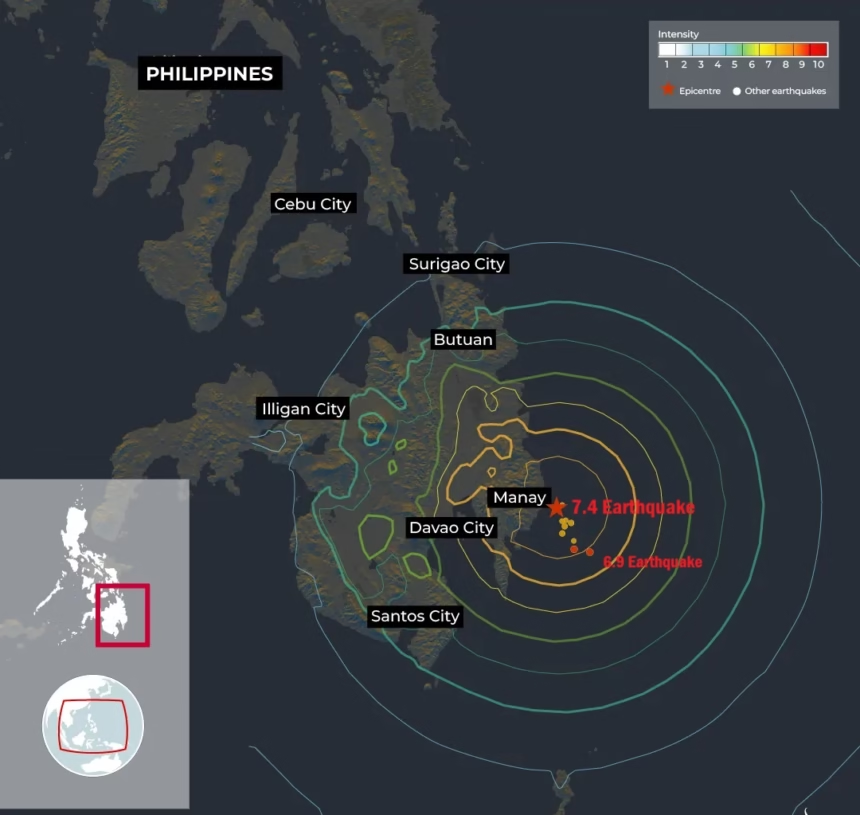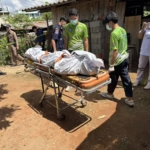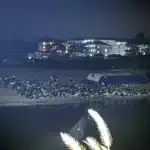MANILA – Two strong earthquakes struck the southern Philippines. The first, a magnitude 7.4, hit at 9:43 a.m. local time just off Davao Oriental. The epicentre sat about 20 kilometres southeast of Manay, near the Philippine Trench, where the Philippine Sea Plate dives beneath the Sunda Plate.
The quake sent intense shaking across Mindanao, killing at least seven people, injuring hundreds, and damaging buildings across several provinces. Hours later, at around 7:12 p.m., another tremor, measured at magnitude 6.9 by local authorities and 6.7 by the U.S. Geological Survey, rattled the same area.
The second shock deepened the crisis and forced new evacuations. These blows came days after a lethal quake in the central Philippines, leaving the country on edge along the Pacific Ring of Fire.
The morning 7.4 quake was felt strongly in Davao City, a city of about 1.8 million residents. Verified clips on social media showed workers bracing desks as lights swung and buildings creaked. In Manay and nearby coastal towns, shaking lasted 30 to 40 seconds. The movement toppled structures and set off landslides that buried homes and roads.
Local officials reported a partial hospital collapse in Davao Oriental that trapped patients, cracked school buildings that sent pupils fleeing to fields, and a gaping breach in a mall façade in Butuan City that scattered debris over car parks. Large parts of Mindanao lost power, and mobile networks clogged as people tried to reach loved ones.
Tsunami Warning Issues
Those confirmed dead included two elderly residents crushed by debris, a firefighter killed during a rapid inspection, and four patients who later died in crowded hospitals. Hundreds more were treated for fractures, cuts, and shock. Major hospitals in Davao City said incoming cases stretched their capacity.
Because the quake was offshore, tsunami alerts were issued at once. PHIVOLCS warned of a possible destructive tsunami within 300 kilometres of the source and ordered people in Davao Oriental, Surigao del Sur, and Dinagat Islands to head to higher ground. Indonesia’s meteorology agency issued similar advice for North Sulawesi and Papua, warning of waves up to one metre above normal tides.
Sirens sounded in fishing towns as families left boats and houses and moved to the hills. The Pacific Tsunami Warning Center then downgraded the threat. It detected only small sea changes in Indonesia, from 3.5 to 17 centimetres, and there were no destructive waves reported in the Philippines. Even so, thousands stayed outside overnight, worried about strong aftershocks.
By late afternoon, sensors had logged more than 50 smaller tremors. Then the second hit arrived. The 6.9 event, centred near Manay at a shallow depth of about 23 kilometres, set off fresh panic. A parked aircraft in Davao City swayed on the tarmac, forcing the crew to delay deplaning.
Students Hospitalized
In Tagum City, residents reported lights cutting out as the shaking resumed. Officials weighed whether to label it an aftershock or a related event. PHIVOLCS renewed tsunami advisories and told coastal residents to move inland. Inspections found added damage.
More cracks spread through school buildings, and a high school in Davao de Oro had 50 students taken to the hospital for dizziness and minor injuries from the morning quake, now worsened by the evening jolt. By nightfall, the death toll had risen to seven.
Search teams worked under floodlights, careful on damaged roads and unstable slopes.
These Friday strikes came only 10 days after another disaster. On 30 September 2025, a magnitude 6.9 earthquake off Cebu province in the Visayas killed at least 79 people and injured more than 1,200. It was the country’s deadliest quake since 2013. The main shock hit at 9:59 p.m., with an epicentre about 10 kilometres east of Daanbantayan near Bogo City.
PHIVOLCS first listed it at magnitude 6.7. The quake was shallow, about 5 kilometres deep, which increased the shaking. In Bogo, a city of about 90,000, half of the deaths came from mid-rise buildings that collapsed and trapped people at night.
The bell tower of the 139-year-old Daanbantayan Church fell, a stark symbol amid wrecked homes, a McDonald’s outlet, and Saints Peter and Paul Parish on Bantayan Island. Landslides cut off rural roads. Cebu City saw widespread power failures.
More than 10,000 aftershocks followed, including a magnitude 5.3 on 3 October. The disaster displaced 23,562 people and damaged 71,996 houses, with 4,969 beyond repair.
Cebu, Philippines Still Recovering
Cebu’s governor declared a state of calamity and sent out aid, even as heavy rain slowed teams in the field. The National Disaster Risk Reduction and Management Council counted 669,794 people affected. Outages also hit Leyte, Samar, and Bohol.
International partners offered help, including the U.S. and Japan, as President Ferdinand Marcos Jr. promised support. The scale shocked many experts. Cebu is less known for strong quakes, and the fault involved had not produced this level of shaking in about four centuries.
The country’s exposure to earthquakes comes from its place along the Ring of Fire, where many tectonic plates meet. The Philippines records hundreds of quakes each year.
The Philippine Trench, tied to a deadly magnitude 8.0 quake in 1976 that killed about 8,000 people due to a tsunami, is linked to the two recent Mindanao events. Past disasters offer a sobering context.
Twin magnitude 6.9 quakes struck Mindanao in 2019, killing two people. In 2013, a magnitude 7.2 earthquake in Bohol and Cebu killed 220 people and damaged historic churches. PHIVOLCS lists six major events, magnitude 7.1 to 8.3, in Davao Oriental since 1885. Building standards remain uneven in rural areas, which worsens damage and casualties.
After the 10 October quakes, President Marcos ordered rapid aid once areas were safe for entry. Lawmakers, including Jose Alvarez, pressed to increase the 2025 disaster budget. Classes were suspended, ports paused operations, and people prepared for more shaking.
PHIVOLCS warned of strong aftershocks, up to magnitude 6.4. By 11 October, 59 tremors of magnitude 2.5 and above were logged within a day near Santiago and Manay. Personal accounts captured the fear. Richie Diuyen, a 46-year-old official from Manay, said it was the strongest he had ever felt. In Cebu, families in Bogo slept by the roadside, startled by fresh jolts.
Resources are stretched thin. Cebu was still recovering, with about 80,000 displaced and churches in ruins, when Mindanao shook. Public calls grew for tougher standards and smarter planning. Priorities included retrofitting schools, improving alerts, and regular community drills. PHIVOLCS kept urging caution as the sequence continued.
Offers of help from abroad and messages of support kept arriving. The focus now is on safer buildings, clear warnings, and steady support for people who lost homes and work. In a nation of 7,641 islands, daily life often sits close to active faults. Prepared communities and strong structures save lives when the ground moves.














